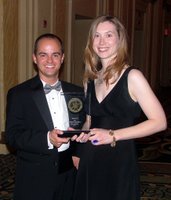 A maddening schedule has kept me away from the keyboard, at least from blogging. There have been a couple requests to follow-up on my New York trip. It was stellar. Some of the details would be too cumbersome, but I hope to share a few anecdotes later. Let me begin though by congratulating Sarah Ashworth who was on hand to accept the award and Kyle Palmer, two colleagues who worked tirelessly on the "What's on the Line?" documentary. Both are consummate professionals.
A maddening schedule has kept me away from the keyboard, at least from blogging. There have been a couple requests to follow-up on my New York trip. It was stellar. Some of the details would be too cumbersome, but I hope to share a few anecdotes later. Let me begin though by congratulating Sarah Ashworth who was on hand to accept the award and Kyle Palmer, two colleagues who worked tirelessly on the "What's on the Line?" documentary. Both are consummate professionals.The Edward R. Murrow awards ceremony was a blast with an all-star lineup including Brian Williams, Campbell Brown, Kate Snow, Soledad O'Brien, Gil Gross and many others. It was inspiring to be in a room with the creme de la creme of our industry, people who yearn to carry forth the spirit of true broadcast journalism. Unquestionably, the standards Murrow set forth are alive and well.
No doubt there are hurdles for our industry, the least of which is fragmentation with audiences getting their information in new ways, some still in their infancy. Perhaps we can view this new reality as a reminder that we in broadcast news must earn viewers' trust and interest. Otherwise, we as some scholars predict, face extinction. I'll leave you with an oft-quoted excerpt from Murrow's address to the Radio and Television News Directors Association 48 years ago. Its message is as important now as it was then in the early days our two mediums. Referring to television Murrow opined, "This instrument can teach, it can illuminate; yes, it can even inspire. But it can do so only to the extent that humans are determined to use it to those ends. Otherwise it is merely wires and lights in a box."
